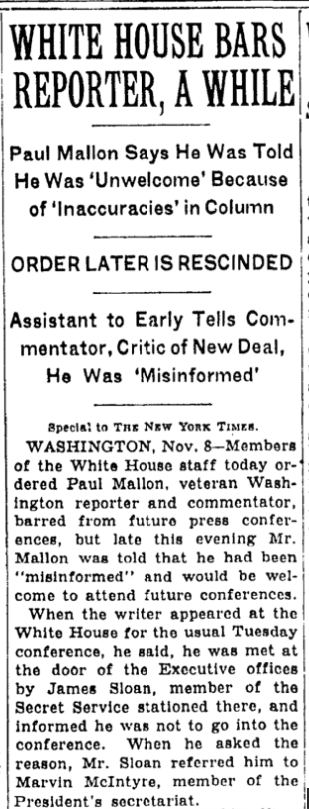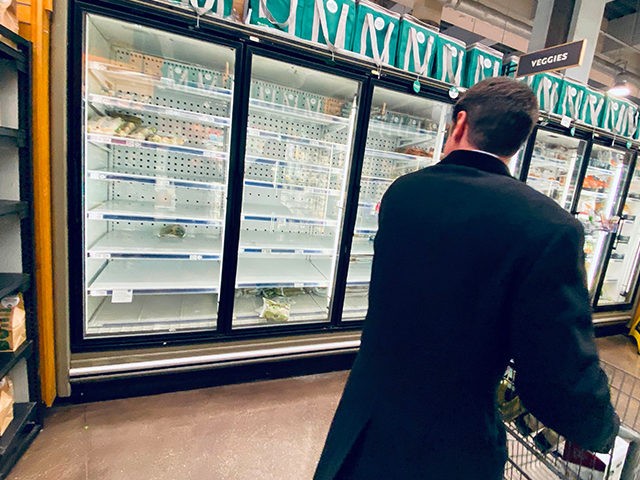The economic concept that “there is no such thing as a free lunch” supposedly originated in a column by Paul Mallon in 1942.

A clipping from the New York Times on November 9, 1940, about UPI reporter Paul Mallon’s banishment from the FDR White House’s press briefings.
Mallon was a former supporter of Franklin Delano Roosevelt turned anti-New Dealer who became the first syndicated opinion columnist in the United States after a 10-year-long stint with The United Press. He was briefly declared persona non grata at the FDR White House for alleged “inaccuracies” in his column, which was New Deal-speak for what now gets called disinformation.
Supposedly, saloons across the United States had been in the habit of advertising free lunches as a way to lure customers and to keep them bellying up to the bar and paying for alcohol.
Mallon deployed the phrase in response to a call by Vice President Henry Wallace for the U.S. to supply the world with enough financial aid to supply everyone with “minimum standards of food, clothing and shelter.” Wallace had said that since “we can afford tremendous sums of money to win the war, we can afford to invest whatever amount it takes to win the peace.” Mallon’s response was that aid was a poor substitute for actual economic development.
“Mr. Wallace neglects the fact that such a thing as a ‘free’ lunch never existed. Until man acquires the power of creation, someone will always have to pay for a free lunch,” Mallon replied.
Thirty-three years later, the libertarian economist Milton Friedman titled a collection of essays There’s No Such Thing as a Free Lunch. A year later, Friedman was awarded the Sveriges Riksbank Prize in Economic Sciences in Memory of Alfred Nobel—commonly, if not quite accurately, called the Nobel Prize in Economics. That book is probably the source of the fame of the phrase. We will note in passing that a signed first edition of Friedman’s book will set you back more than $4,000.
What if the problem is not just the nonexistence of free lunch but a shortage of lunches altogether? S&P Global said Monday that manufacturers worldwide reported sustained price and supply pressures during April. One of the main lessons of our current economic troubles is what was at the heart of Mallon’s response to Wallace: that the creation of goods and services, the supply side of the economy, matters. As Mallon put it in a 1946 column, “Production is the lifeblood of a nation.” We’re experiencing uncomfortably high inflation because accommodative monetary policy from the Federal Reserve and deficit-driven fiscal stimulus pumped demand up so much that it outran the global economy’s ability to supply goods.
“Food markets also saw a sharp uptick in reported disruptions. Supply shortages surged in April to reach a joint-record level as the war in Ukraine continued to hit global food exports Reports of increased food prices were meanwhile at the second-highest on record,” wrote S&P Global economist Usamah Bhatti in Monday’s report.
This complicates the Federal Reserve’s task. While the Fed has tools to reduce demand by tightening credit conditions, raising interest rates could also restrain the expansion of the supply side of the economy. In any case, there’s very little it can do to expand global food supplies. Food shortages will push up food prices, making reducing headline inflation even tougher and likely requiring even higher interest rates. That, in turn, raises the risk that monetary tightening will tilt the economy into recession.
The Fed is widely expected to raise interest rates by 50 basis points at the end of the Federal Open Market Committee meeting on Wednesday. The open question is how much the Fed will have to raise rates at the subsequent meeting. The doves now say the Fed will creep along at 25 basis points each meeting, but they are increasingly in the minority. Far more common is the view that the Fed will have to implement several 50 basis point hikes. The hawks are now openly predicting a 75 basis point hike at the June meeting.
We’ve come a long way from transitory inflation. As Mallon put it in a column in July of 1944, “Pressure groups can deceive us, but only temporarily. Truth is an obstinate, inevitable leveler. It will insist on being dominant in the end, no matter how many words are heaped upon it.”

COMMENTS
Please let us know if you're having issues with commenting.